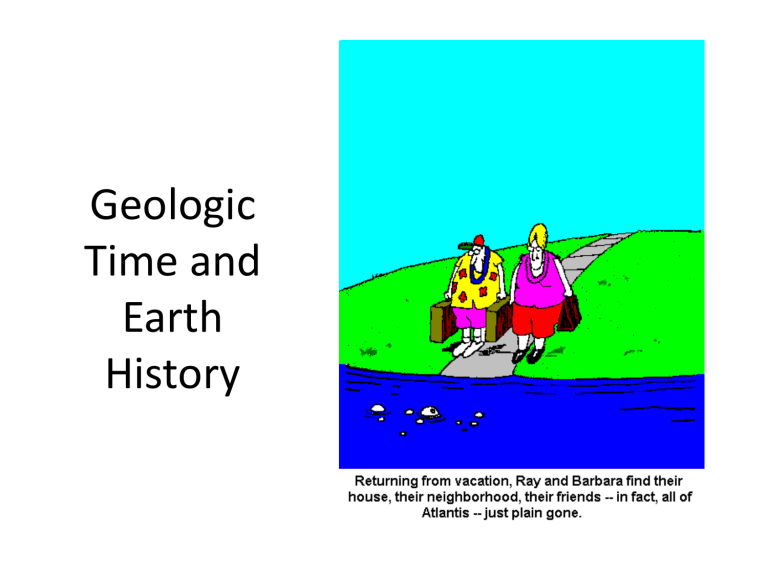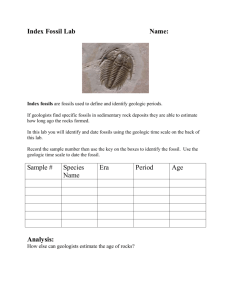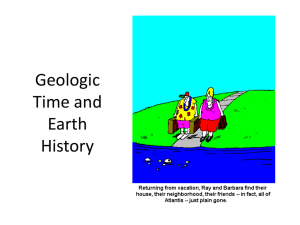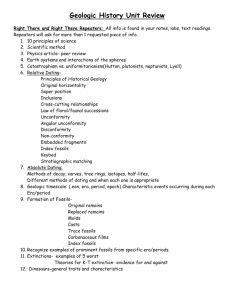Geologic Time and Earth History

Geologic
Time and
Earth
History
Two Conceptions of Earth History:
Catastrophism
• Assumption: Great Effects Require Great Causes
• Earth History Dominated by Violent Events
Uniformitarianism
• Assumption: We Can Use Cause And Effect to
Determine Causes of Past Events
• Finding: Earth History Dominated by Small-scale
Events Typical of the Present.
• Catastrophes Do Happen But Are Uncommon
Uniformitarianism
Continuity of Cause and Effect
• Apply Cause and Effect to Future -
Prediction
• Apply Cause and Effect to Present -
Technology
• Apply Cause and Effect to Past –
Uniformitarianism
The Present is the Key to the Past
Ripple Marks, Bay Beach
Fossil Ripple Marks, Baraboo Range
Modern Mud Cracks
Fossil Mud Cracks, Virginia
Two Kinds of Ages
Relative - Know Order of Events But Not
Dates
• Civil War Happened Before W.W.II
• Bedrock in Wisconsin Formed Before The
Glaciers Came
Absolute - Know Dates
• Civil War 1861-1865
• World War II 1939-1945
• Glaciers Left Wisconsin About 11,000 Years
Ago
Superposition:
Mindoro Cut,
Wisconsin
Geologic
Map
Fossils
Remains of Ancient Plants And
Animals, Evidence of Life
Commonly Preserved:
Hard Parts of Organisms:
• Bones
• Shells
• Hard Parts of Insects
• Woody Material
Rarely Preserved
Soft or Easily Decayed Parts of Organisms:
• Internal Organs
• Skin
• Hair
• Feathers
Types of Fossils
• Original Material
• Casts & Molds
• Replacement (Petrified Wood)
• Carbonized Films (Leaves)
• Footprints, Tracks, Etc.
– “Trace Fossils” – Our only preserved record of behavior of fossil organisms
Dinosaur
Tracks,
Texas
Rubbing
Rock?
Wisconsin
Rubbing
Rock?
California
Pseudofossils
Look Like Fossils But Aren't
• Dendrites
• Concretions
Pseudofossils
Natural or Sculpture?
Johannes Beringer’s “Fossils”
Beringer’s
Book
Where Fossils Occur
Almost Exclusively in Sedimentary Rocks
• Heat of Melting or Metamorphism Would Destroy
Almost Every Type of Fossil
• Rare Exceptions:
– Some Fossils in Low-grade Metamorphic Rocks
– Trees Buried by Lava Flow
To Be Preserved, Organisms Have to Be:
• Buried Rapidly After Death
• Preserved From Decay
Fossil Tree in Lava Flow, Hawaii
Good Index Fossils
• Abundant
• Widely-distributed (Global Preferred)
• Short-lived or Rapidly Changing
Correlation
Quaternary
Tertiary
Cretaceous
The Geologic Time Scale
Latin, “fourth”
Latin, “third”
Latin creta
, “chalk”
1822
1760
1822
Jurassic
Triassic
Permian
Jura Mountains, Switzerland
Latin, “three-fold”
Perm, Russia
Carboniferous Carbon-bearing
Devonian
Silurian
Ordovician
Cambrian
Devonshire, England
Silures , a pre-Roman tribe
1795
1834
1841
1822
1840
1835
Ordovices , a pre-Roman tribe 1879
Latin Cambria , “Wales” 1835
Absolute Ages: Early Attempts
The Bible
• Add up Dates in Bible
• Get an Age of 4000-6000 B.C. For Earth
• John Lightfoot and Bishop Ussher - 4004
B.C. (1584)
• Too Short
Absolute Ages: Early Attempts
Salt in Ocean
• If we know rate salt is added, and how much salt is in ocean, can find age of oceans.
Sediment Thickness
• Add up thickest sediments for each period, estimate rate.
Both methods gave age of about 100 million years
• Problem: Rates Variable
Age of The Sun
• If sun gets its heat from burning or other chemical reactions, could only last 10,000 years or so.
• Best 19th century guess: sun was slowly contracting.
• Problem: only 30 million years ago, sun would have extended out to earth's orbit!
• Geologists wanted more time, but you can't fight the laws of physics...
• Sun actually gets its energy from nuclear reactions and can keep going for billions of years
• The Geologists were right after all. Go Team.
The Fundamental Rule of
Absolute Ages
The Earth is older than everything on or in it
-Except its atoms
-All ages are minimum ages
Radiometric Dating: Half-Life
Present Radiometric Dating Methods
Cosmogenic
• C-14 5700 Yr.
Primordial
• K-Ar (K-40) 1.25 B.Y.
• Rb-Sr (Rb-87) 48.8 by
• U-235 704 M.Y.
The
Geologic
Time Scale
Some Geologic Rates
Cutting of Grand Canyon
• 2 km/3 m.y. = 1 cm/15 yr
Uplift of Alps
• 5 km/10 m.y. = 1 cm/20 yr.
Opening of Atlantic
• 5000 km/180 m.y. = 2.8 cm/yr.
Uplift of White Mtns. (N.H.) Granites
• 8 km/150 m.y. = 1 cm/190 yr.
Some Geologic Rates
Movement of San Andreas Fault
• 5 cm/yr = 7 m/140 yr.
Growth of Mt. St. Helens
• 3 km/30,000 yr = 10 cm/yr.
Deposition of Niagara Dolomite
• 100 m/ 1 m.y.? = 1 cm/100 yr.
1 Second = 1 Year
• 35 minutes to birth of Christ
• 1 hour+ to pyramids
• 3 hours to retreat of glaciers from Wisconsin
• 12 days = 1 million years
• 2 years to extinction of dinosaurs
• 14 years to age of Niagara Escarpment
• 31 years = 1 billion years
Were The Dinosaurs Failures?
Dinosaurs: 150,000,000 years
Recorded History: 5000 years
• For every year of recorded history, the dinosaurs had 30,000 years
• For every day of recorded history, the dinosaurs had 82 years
• For every minute of recorded history, the dinosaurs had three weeks







